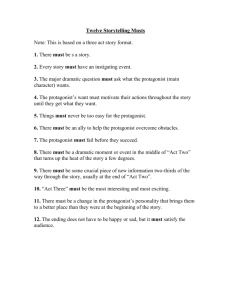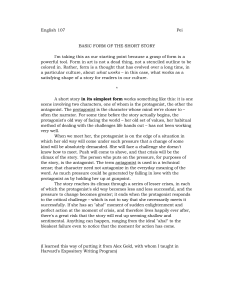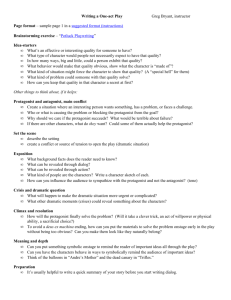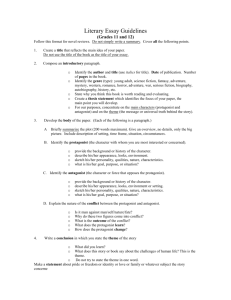A Stylistic Analysis of the Short Story “Theft”
advertisement
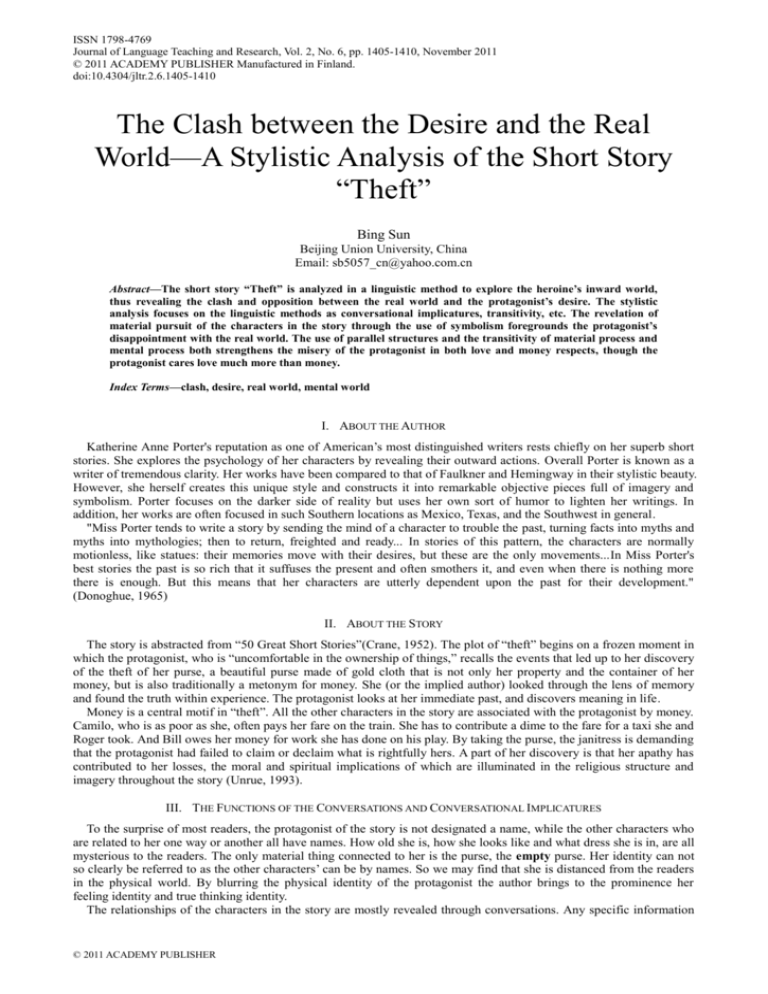
ISSN 1798-4769 Journal of Language Teaching and Research, Vol. 2, No. 6, pp. 1405-1410, November 2011 © 2011 ACADEMY PUBLISHER Manufactured in Finland. doi:10.4304/jltr.2.6.1405-1410 The Clash between the Desire and the Real World—A Stylistic Analysis of the Short Story “Theft” Bing Sun Beijing Union University, China Email: sb5057_cn@yahoo.com.cn Abstract—The short story “Theft” is analyzed in a linguistic method to explore the heroine’s inward world, thus revealing the clash and opposition between the real world and the protagonist’s desire. The stylistic analysis focuses on the linguistic methods as conversational implicatures, transitivity, etc. The revelation of material pursuit of the characters in the story through the use of symbolism foregrounds the protagonist’s disappointment with the real world. The use of parallel structures and the transitivity of material process and mental process both strengthens the misery of the protagonist in both love and money respects, though the protagonist cares love much more than money. Index Terms—clash, desire, real world, mental world I. ABOUT THE AUTHOR Katherine Anne Porter's reputation as one of American’s most distinguished writers rests chiefly on her superb short stories. She explores the psychology of her characters by revealing their outward actions. Overall Porter is known as a writer of tremendous clarity. Her works have been compared to that of Faulkner and Hemingway in their stylistic beauty. However, she herself creates this unique style and constructs it into remarkable objective pieces full of imagery and symbolism. Porter focuses on the darker side of reality but uses her own sort of humor to lighten her writings. In addition, her works are often focused in such Southern locations as Mexico, Texas, and the Southwest in general. "Miss Porter tends to write a story by sending the mind of a character to trouble the past, turning facts into myths and myths into mythologies; then to return, freighted and ready... In stories of this pattern, the characters are normally motionless, like statues: their memories move with their desires, but these are the only movements...In Miss Porter's best stories the past is so rich that it suffuses the present and often smothers it, and even when there is nothing more there is enough. But this means that her characters are utterly dependent upon the past for their development." (Donoghue, 1965) II. ABOUT THE STORY The story is abstracted from “50 Great Short Stories”(Crane, 1952). The plot of “theft” begins on a frozen moment in which the protagonist, who is “uncomfortable in the ownership of things,” recalls the events that led up to her discovery of the theft of her purse, a beautiful purse made of gold cloth that is not only her property and the container of her money, but is also traditionally a metonym for money. She (or the implied author) looked through the lens of memory and found the truth within experience. The protagonist looks at her immediate past, and discovers meaning in life. Money is a central motif in “theft”. All the other characters in the story are associated with the protagonist by money. Camilo, who is as poor as she, often pays her fare on the train. She has to contribute a dime to the fare for a taxi she and Roger took. And Bill owes her money for work she has done on his play. By taking the purse, the janitress is demanding that the protagonist had failed to claim or declaim what is rightfully hers. A part of her discovery is that her apathy has contributed to her losses, the moral and spiritual implications of which are illuminated in the religious structure and imagery throughout the story (Unrue, 1993). III. THE FUNCTIONS OF THE CONVERSATIONS AND CONVERSATIONAL IMPLICATURES To the surprise of most readers, the protagonist of the story is not designated a name, while the other characters who are related to her one way or another all have names. How old she is, how she looks like and what dress she is in, are all mysterious to the readers. The only material thing connected to her is the purse, the empty purse. Her identity can not so clearly be referred to as the other characters’ can be by names. So we may find that she is distanced from the readers in the physical world. By blurring the physical identity of the protagonist the author brings to the prominence her feeling identity and true thinking identity. The relationships of the characters in the story are mostly revealed through conversations. Any specific information © 2011 ACADEMY PUBLISHER 1406 JOURNAL OF LANGUAGE TEACHING AND RESEARCH about her, if there is, is little by little unfolded to the readers through her interaction and conversations with other characters. The only utterance she made to Camilo is “You know it simply will not do” when he insisted on a taxi. This is a very simple, economical and strong statement carrying something that one is embarrassed to explain. There is no hesitation with “simply…not”. We and Camilo together, sense that there is no room to change her mind. At that time of a raining night, Camilo’s insistence must be understandable, and he was behaving like a gentleman. Maybe he really cares about her but is not able to afford the care. No money things are mentioned in their talks. Now let’s have a look at her conversation with Roger, who seems to be a close friend of her because “they exchanged a glance full of long amiable associations”. The conversation is initiated by the following: She said: “The more it skids the calmer I feel, so I really must be drunk.” The former part of the statement may be true or may not be true. We will rely on the coming up to judge what she really intends to say. If she is stating something in a as-a-matter-of-fact tone, she could have just said: “I’m really drunk” or “I must be drunk”. A word of certainty in combination with a word of uncertainty is implied to reveal her indirect desire to be consoled (for she just received a letter). What is meant is more than what is said. After all, they are acquainted with each other a long time. It’s very natural for a lady to say something like that in seeking comfort from a friend like that. But Roger filters out the implication part “really”, and keeps the literal part “must be”. “You must be,” said Roger. “This bird is a homicidal maniac, and I could do with a cocktail myself this minute.” He probably thinks he is humorous by referring to a certain kind of cocktail wine with a word from the animal category, presupposing that both of them understand “cock” is a bird. This reply is just a reply for it doesn’t carry much care for the protagonist. If his reply is “you really are” instead of “you must be”, the effect and the consequence could be very different. Then it would be inconsistent and unreasonable for him to talk about things concerning himself. In the latter part of the conversation, money things are mentioned first by Roger “I’ve just enough if you’ll add ten cents,” and then his complaint about the “holding out”, which is a metonym for “giving money”. We notice that the protagonist responds, but with indifference. The readers now know more than Roger about what she really wants to talk about. Shouldn’t amiable friends be understanding? If yes, it’s reasonable; if not, then there is the irony. The conversational implicature (Grice, 1989, p24-37) is not successfully taken by another side. In this conversation both the addresser and the addressee superficially are exchanging something as if they know much of each other. There is not much concern for each other even though at the end of conversation Roger presumably makes a note that she should take aspirin …to remind her of his being a friend. It’s too late and means nothing but a sign to end the conversation. What we feel more and more is the indifference to each other, and this indifference is most strengthened in the following conversation with Bill, on whose play, she had a scene. He said: “For Christ’s sake, come in and have a drink with me. I’ve had some bad news.” Bad news for him or her? And this is immediately followed by his comment “You’re perfectly sopping,” He notices that she just comes back from the rain, but is still determined to keep her in his boring talk about his play being rejected and complaint of his wife’s extravagance because giving her ten dollars every week of my unhappy life is too much for him. And all this makes him on the edge of weeping again. The conversational implicature leads us to the inference that the bad news must involve her for his insistence on her listening to his complaint at that an hour of that night. We notice that this part takes up a large amount of discourse time. This evidence, on the one hand, shows that he is cruel regardless of the state the protagonist is in. On the other hand, he seems to violate the maxim of relation of cooperative principle in conversation in an attempt to behave like a “gentleman” not to break out the bad news directly that he is not able to pay her. This violation of maxim of relation actually doubles his cruelty in that he prolongs her suffering both physically and mentally. The protagonist’s misery is highlighted. His topic is only money things. His wife’s asking for ten dollars a week can be extravagant, and he even weeps for money losses repeatedly. Love and friendship are all replaced by money. This money worshipping attitude is easily associated with his cruelty. To this long part of monologue, she takes her turn, but in another direction, “Well, this is a pretty rug, anyhow,” which works as a transition to her mentioning the payment. In contrast to Bill’ violation, she also violates the maxim of relation, in hopes that he will stop self torturing. She attempts the payment request and is refused. So it is evident that the protagonist is also passive in the material world, in addition to her love world. IV. SYMBOLISM Both the purse and the hats are used symbolically in this short story. Their relations to their possessors are understood indispensable. It seems that a lady cannot do without a purse and a man cannot do without a hat. And their attitudes towards their possessions (hats and purse) reflect their attitudes towards material possessions and life. In this story, each of the men except Bill is identified by his hat. The hat serves to symbolize a man’s status as well. Camilo is wearing a new hat of pretty biscuit shade. He cannot afford but lets the rain spoil his hat. He is a young man, who maybe just starts his career and is not totally accustomed to the society, because he only manages a set of smaller courtesies, ignoring the larger and more troublesome ones. He is not quite sure how to behave appropriately in this © 2011 ACADEMY PUBLISHER JOURNAL OF LANGUAGE TEACHING AND RESEARCH 1407 society. On the one hand, he tends to be chivalrous; on the other hand he is restricted by the reality. In the protagonist’s eyes, he is quite inexperienced and still does not know how to fit into the society, for it never occurred to him to buy anything of a practical color. Perhaps he is quite realistic but cannot afford to be realistic. What he chooses and what he does cannot be integrated into one as a whole. He is trying to protect his hat against the rain, but meantime is afraid of being suspected of such an attempt. The subtle irony is exploited through his awkward reaction to the reality. The absent Eddie, on the other hand, is quite different from Camilo. He always wears shabby hats, precisely seven years old. Eddie, seen only in the protagonist’s memory, doesn’t value the material object beyond its usefulness. Seven symbolically suggests a cycle in the creation of the world in religion. Eddie seems to be quite exposed to the society and he knows what is good and what is bad; what is right and what is wrong. His experience with the whole cycle of the world helps in his attitude towards to life. Apparently this attitude is appreciated by the protagonist, for they sat with a careless and incidental rightness on Eddie. Roger protects his hat from the rain by buttoning it up inside his overcoat. He is much more practical and apathetic than Camilo. To a large extent, he is careful and takes no risk in treating his material object. He openly shows his attitude towards material things and life. Bill, not associated with a hat, is the least enigmatic or sympathetic of all the characters. He doesn’t bother to have a hat to show his attitude towards material possessions and life. He just openly speaks them out. The protagonist treats her purse the same way as Eddie does. She shares Eddie’s attitudes towards material things. The attitude towards the purse can be understood both in material sense and in love sense. No mention is made of her protection of her purse from the rain while other characters are making various attempts to protect their hats. The fact is that her purse gets wet inside out. In another sense, she values the purse very much though it is empty because it is a present from someone she loves. The claiming back of the stolen purse reveals that she values love more than material things. V. PARALLELISTIC STRUCTURE A writer’s choice of language is an attempt to reveal artistic principle. Leech & Short (1981) introduce a method of linguistic analysis, ie: list check of grammatical categories and lexical categories. We may try to approach the following paragraph in their method. In this moment she felt that she had been robbed of an enormous number of valuable things, whether material or intangible: things lost or broken by her own fault, things she had forgotten and left in houses when she moved: books borrowed from her and not returned , journeys she had planned and had not made, words she had waited to hear spoken to her and had not heard, and the words she meant to answer with; bitter alternatives and intolerable substitutes worse than nothing, and yet inescapable: the long patient suffering of dying friendships and the dark inexplicable death of love—all that she had had, and all that she had missed, were lost together, and were twice lost in this landslide of remembered losses. (p187) This omniscient point of view helps the readers with the access to the protagonist’s inward activities. It is half-way the character’s thought and half-way the narrator’s underlying comment. It neutrally summarizes the protagonist’s unsuccessful life both in material aspect and in love aspect. The sentence pattern is balanced through the conjunctive word and, which gives the readers impression of “doubleness”. This may account for the reason why the writer uses and instead of but. On the other hand, the things before and is either positive or negative, thus the consequences after and either contrasting the positive wills or doubling the negative happenings. As a result, the function of the word and is both that of contrast and doubleness. It echoes the other word twice in the coming part. And all these ands accumulate the losses in her life. The syntactic congruency conflates the narrative flow and the trace of thought of the protagonist. In addition, the adjectives intolerable, inescapable, and inexplicable, all carrying symmetrical “in-” property, which stresses the unseenness and untouchedness, reinforces the protagonist’s helplessness and passiveness in her friendship and love world. The three adjectives are attributive, and they reflect the protagonist’s psychological reality. They mainly refer to her relationship with others and her love. Though they do not seem to carry much emotional features, readers surely feel the unhappiness in the protagonist under the superficial calmness. They help in the escalation of material losses into the intangible losses. And finally the climax of her being helpless and unhappiness is reached through the use of losses. The redundant uses of losses highlight the theme of the protagonist’s being denied against her will the “material” things, which are visible and “intangible” things, which are love and friendship. VI. THIRD PERSON POINT OF VIEW OF MULTIPLE SELECTIVE OMNISCIENCE Multiple Selective Omniscience is introduced by Friedman according to Shen Dan (1998, p208). The story elements such as the character’s words, activities, appearances, background are conveyed to the readers through the character’s mind. This point of view directly presents the character’s thoughts and feelings. They waited on the traffic at Fortieth Street and Sixth Avenue, and three boys walked before the nose of the taxi. Under the globes of light they were cheerful scarecrows, all very thin and tall wearing very seedy snappy-cut suits and gay neckties. They were not very sober either, and they stood for a moment wobbling in front of the car, and there was an argument going on among them. They leaned toward each other as if they were getting ready to sing, and the first © 2011 ACADEMY PUBLISHER 1408 JOURNAL OF LANGUAGE TEACHING AND RESEARCH one said: “When I get married it won’t be jus’ for getting married, I’m gonna marry for love, see?” and the second one said, “Aw, gwan and tell that stuff to her, why n’t yuh?” and the third one gave a kind of hoot, and said: “Hell, dis guy? Wot the hell’s he got?” and the first one said: “Aaah, shurrup yuh mush, I got plenty.” Then they all squealed and scrambled across the street beating the first one on the back and pushing him around. “Nuts,” commented Roger, “pure nuts.” Two girls went skittering by in short transparent raincoats, one green, one red, their heads tucked against the drive of the rain. One of them was saying to the other, “Yes, I know all about that. But what about me?” You’re always so sorry for him…” and they ran on with their little pelican legs flashing back and forth. (p184) In the story, the scene of the boys and the girls is selectively presented before the readers through the character’s eyes and mind. We read what the character chooses to think, and we hear what the character picks out to hear. The narrator here seems to assume the same status as the character in observation. There is a formula, Narrator = Character, which stands for the notion of “inner focalization”. This inner focalization in the third person point of view helps us to the direct access to the character’s mental world. This typical mixing point of view of narrator and character is also analogous to linguistic expression. According to Cui Xiliang (2001), if the narrative perspective of observation is inside the scene container, it is inner-perspective scene; if it is outside the scene container, it is called exo-perspective scene. So the narrator is inside the scene container with the character, assuming an inner-perspective. Actually, it’s the character in the guise of narrator who means to convey to us something of her true feelings. The boys’ talk about “marrying for love” and the girls’ talk about “being sorry for him” are meant to be cohesive to the theme of the story. The protagonist she is not going to be married because the one who writes her does not love her any more. Perhaps she is also sorry for him the way the young girl is feeling for him. The cohesive ties are explicitly worded naturally through the young boys’ mouths and the young girls’ mouths (said is easier than done for young people), and they easily lead us into her implicit mental world. The readers touch the desire there. She wants something but is not satisfied. VII. TRANSITIVITY OF MENTAL PROCESS AND MATERIAL PROCESS In the ideational meta-function, Halliday (1994) says that the transitivity system construes the world of experience into a manageable set of process types. The clearly distinguished two are the outer experience, the process of the external world, and inner experience, the process of consciousness. The grammatical categories are those of material processes and mental processes. We try to adopt this functional approach to look at the material processes and mental processes concerning the protagonist. We try to find the prototypical ones in the story. Verbs representing the material processes are: had walked, staggered slightly, settled back against, went upstairs, tore the letter, set the cup carefully, took the purse, held the purse out, turning away, laid the purse, etc. The transitivity of the process shows the relation of agent (actor) and patient (goal) or just the experiencer of a certain action and the action itself. These verbs demonstrate the dynamic interaction of her with the outer world. And they are mostly the actions connected with her feet and hands. They are simple actions without too much violent body movement. And these actions are seldom repeated throughout the discourse. Verb phrases, if analyzed like this, can mean something (Wright & Hope, 1996). The simple verb phrases are to give the texts their matter-of-fact atmosphere. On the other hand, the protagonist herself is much simple and decisive in action, and would not be interfered with by much disturbance from outer world. Also, the slow but determined actions revealed that she reacted to the happenings in the world in a way she already knew the outcomes and would not act on impulse like young girls. It seemed that she had experienced too much disappointment in her life and she did not necessarily care any more. Some of the actions are modified by “steadily” “carefully”, like in the sentences: Carefully she tore the letter into narrow strips and touched a lighted match to them in the coal grate. She does not show any violent responses after finishing the letter. Carefully here takes initial place of the clause and serves as the theme, which has the salient status in a sense, hence more or less psychologically carrying more weight than the action itself. It evidently reveals the inner state of the protagonist. The outward actions are unusually highlighted to conceal her inward excitement. Another one is She set the cup carefully in the center of the table, and walked steadily downstairs,… This happened just after she found her purse missing, and there is anger rising in her. The actions in consequence are respectively modified by these two adverbs. The more excited inside, the calmer she will become outside. And this is justified by the remarks made by herself “The more it skids the calmer I feel,…”, which is typically characteristic of the protagonist. This paradoxical inward and outward activities implicitly demonstrates the clash between her will and the reality. Verbs representing mental processes are: had intended, kept thinking, compared, had not feared, felt, was thinking, remembered, felt, etc. These verbs demonstrate the static inner activities. A lot of them are directly indicating the true feelings of her inner world. The inward actions are more vivid than the outward actions, though they cannot be seen. She remembered how she had never locked a door in her life, on some principle of rejection in her that made her uncomfortable in the ownership of things, and her paradoxical boast before the warnings of her friends, that she had never lost a penny by theft; and she had been pleased with the bleak humility of this concrete example designed to illustrate and justify a certain fixed, otherwise baseless and general faith which ordered the movement of her life © 2011 ACADEMY PUBLISHER JOURNAL OF LANGUAGE TEACHING AND RESEARCH 1409 without regard to her will in the matter. This is actually a free indirect thought. In the following part we are going to read the grammatical metaphor of transitivity in terms of Hallidayian method. She had sat down and read the letter over again: but there were phrases that insisted on being read many times, they had a life of their own separate from the others, and when she tried to read past and around them, they moved with the movement of her eyes, and she could not escape them…(p186) She, actually, was the reader of the letter, to be more technique, the Agent (Actor) of the reading action. The author raises the Goal phrases to the subject position, hence reducing the agentivity of she. The effect of her unwillingness to read the letter is in a sense foregrounded, and the verb insisted on helps much in the effect salience. The reversed Actor-Goal relation is further found in the second clause. That is, the personification of the Goal phrases in the second clause signals a transference from passiveness to activeness because “they had a life”, “they moved”, so as to contrast her helplessness and passiveness to break away from the inescapable real world. “They” stood out because “they had a life of their own separate from the others”. For all her unwillingness, these living phrases were meant (by the writer of the letter) to follow “the movement of her eyes”, while other phrases which might not be as hurting as those living phrases turned out to be rather static (not moving) and unimportant in the news breaking. The author here uses the word “separate” rather than “different” in an attempt to bring it to the congruence to the use of the word “moved” in the following clause. As a result, the phrases in the letter are peeled into two groups, one moving as the foreground, the other being static as the background. Consequently what impresses the readers is that what she wanted was separated away from her, whereas what she did not want could not be escaped by her. We definitely understand she was passive in fulfilling her will. The broken, incomplete arrangement of the words by the author is naturally correspondent to the imaginary scene. “thinking about you more than I mean to … yes, I even talk about you … why were you so anxious to destroy … even if I could see you now I would not … not worth all this abominable … the end…” We may as well take there is icon (a term in cognitive linguistics) between the language form and the imaginary scene, for it is very natural for one to do the broken reading when he tries to concentrate. This may account for one of the reasons. It may account for another reason in another respect. This kind of arrangement with regular intervals in between the sentences indicates that the protagonist is certainly not happy, but not that unhappy as not to be unable to finish the reading. Though the reaction of the protagonist to the letter may not be as strong as the first time (for this is the second time she read the letter), the linear quick and slow eye movement reveals the vertical up and down excitement she is reasonably operating on. So this is also what I mean by iconicity between language form and the physical or mental experience. The broken sentences provide not much but sufficient information concerning the protagonist. Some one is determined to bring an end (through the word “end”) to the love affairs between them, for he cannot stand such a relation (through the word “abominable”). All this is due to her own fault (through the word “destroy”). The semantic progression can be depicted to be going up first (going on) and stopping on the top and then going down (coming back), if we try to focus on the key words in each phrase group. The relationship between protagonist and the man is also bi-directionally depicted in the progression in that there are positive words indicating that it is going for good before “destroy”, and after that there are negative ones indicating that it is going for worse. There are ups and downs and finally end, if we look at the diagram vertically. Semantically the down parts are stronger than the upper parts, because in the information structure negative adjuncts are the focusing adjuncts. As a result they carry heavier semantic weight than other parts in the statements. VIII. CONCLUSION Through stylistic analysis we have a clear understanding of the strong clash between the protagonist’s inward desire and the reality. Her inward mental activities contrast her seemingly peaceful appearance and rather slow reactions. The more she is pressed by the reality, the more violent she is within her. The misfortune in her loss of her purse accompanies the misfortune in her love world and doubles her misery. We do not see much violent reactions from the protagonist towards the theft of love and money, even friendship. Actually we all see that when no desire is shown the suffering the protagonist experiences shall be in its deepest moment. REFERENCES [1] [2] [3] [4] [5] [6] [7] Crane, Milton, ed. (1952). 50 Great Short Stories, Toronto. New York, London, Sydney, Auckland: Bantam Books. Cui Xiliang. (2001). Language Understanding and Cognition. Beijing: Beijing Language and Culture University. Donoghue, Denis, (1965). New York Review of Books, Powell's Books - The Collected Stories of Katherine Anne Porter by Katherine An Porter. http://www. powells.com/search/DTSearch/search?author=Katherine Anne Porter (accessed 15/5/2005). Grice, Paul, (1989). Studies in the Way of Words, 2002, Beijing: Foreign Language Teaching and Research Press, Harvard University Press. Halliday, M.A.K. (1994). An Introduction to Functional Grammar. London: Edward Arnold. Wright, Laura & Jonathan Hope. (1996). Stylistics: A Practical Course book, 2000, Beijing: Foreign Language Teaching and Research Press. Leech, Geoffrey N. & Short. (1981). Style in Fiction: A Linguistic Introduction to English Fictional Prose. 2001, Beijing: © 2011 ACADEMY PUBLISHER 1410 [8] [9] JOURNAL OF LANGUAGE TEACHING AND RESEARCH Foreign Language Teaching and Research Press. Shen Dan. (1998). Narratology and the Stylistics of Fiction. Beijing: Peking University Press. Unrue, Darlene Harbour. (1993). “Katherine Anne Porter, politics, and another reading of Theft”, Studies in Short Fiction, Spring, http://www. findarticles.com/p/articles/mi_m2455/is_n2_v30/ai_14081297/Pg_2. (accessed 15/5/2005) Bing Sun, female, was born in Heilongjiang, China in 1964. She received her Master degree in linguistics from Peking University, China in 2006. She now is an associate professor in the Department of Foreign Languages, Beijing Union University, Beijing, China. Her research interest is functional linguistics and cognitive linguistics. © 2011 ACADEMY PUBLISHER



